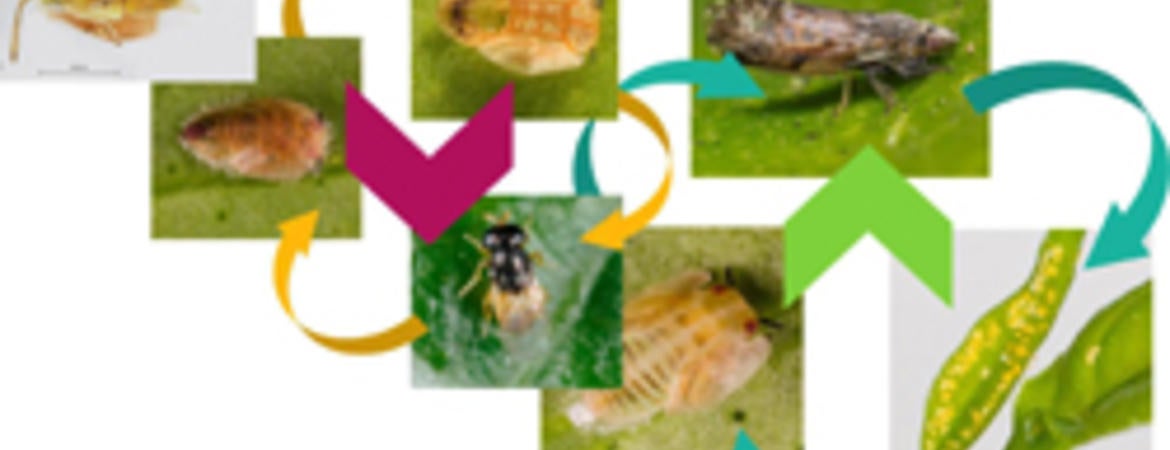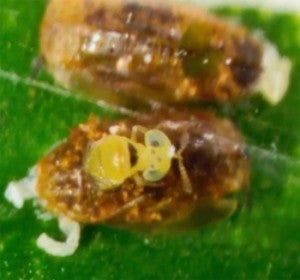
| Written by: Allison Bistline-East Email: a.bistline-east1@nuigalway.ie More Research: UCR Biocontrol Website |
The Problem. In 2008, the Asian citrus psyllid (ACP), Diaphorina citri (Hemiptera: Liviidae), was first detected in California. Since its establishment in California, commercial citrus growers and homeowners alike have become familiar with this notorious pest and the threat it represents as a vector of the bacterium, Candidatus Liberibacter asiaticus, which causes the lethal citrus disease huanglongbing (HLB). As of July 2015, there have been two confirmed cases of HLB-positive citrus trees in California, both on residential properties in Los Angeles County.

Natural Enemies for ACP Biocontrol. Because ACP-HLB poses such a significant threat to the California citrus industry, which generates over $3 billion annually and provides over 26,000 jobs, ACP population control has been a primary focus of both UCR entomologists and the California Department of Food and Agriculture (CDFA). A classical biological control program to reduce ACP populations in urban areas began with the release of Tamarixia radiata in December 2011, and in December 2014, a second parasitoid, Diaphorencyrtus aligarhensis, was added to the release program with the intent of establishing a complementary set of parasitoids that attack ACP nymphs. There has been some question as to how many different natural enemy species are optimal in biological control programs, and in several instances a complex of several species have been shown to be most effective, especially when the target pest infests different environments (Denoth 2002). In its home range, the Indian subcontinent and Asia, a guild of up to nine different parasitoid species were described attacking ACP nymphs by Mohammad Hussain and Dina Nath (1927). However, the identity of just one species, Tamarixia radiata, was determined. This led researchers in the Hoddle lab (UCR) on an investigation to determine the identities of the other parasitoid species putatively attacking ACP nymphs in Punjab Pakistan, with the intent of discovering additional natural enemies to use in the ACP control program in California.
It is likely one of the unnamed species recovered in Hussain and Nath’s (1927) study was Psyllaphycus diaphorinae. Nearly 50 years after the initial study, Mohammed Hayat (1972) formally described P. diaphorinae from specimens recovered in Punjab, India, a region immediately adjacent to Punjab, Pakistan where T. radiata and D. aligarhensis were collected and subsequently released in California for ACP biocontrol. In April 2013, six live female P. diaphorinae were returned to the Insectary and Quarantine Facility at UCR from a natural enemy collecting trip in Punjab, Pakistan. This collection was the first to return live P. diaphorinae, and the recovered females were immediately exposed to ACP nymphs at every juvenile stage to determine the preferred host stage of this potential parasitoid of ACP nymphs.
P. diaphorinae Host Determination. To the surprise of UCR researchers, the preferred host of P. diaphorinae was not ACP at all. After exposing the P. diaphorinae females to 90 ACP nymphs no successful parasitism was observed. The females were then subjected to further exposure trials, this time sequentially to T. radiata larvae developing inside ACP (“mummies”), D. aligarhensis mummies, and additional unparastitized ACP nymphs. Contrary to the description given by Hayat, which was based solely on the morphology of preserved specimens, the results of these exposure trials determined that P. diaphorinae actually parasitizes developing T. radiata or D. aligarhensis within an ACP nymph, and not the ACP nymph itself! This type of parasitism, where one parasitoid targets another within a host, is known as hyperparasitism, and these types of parasitoids are known as hyperparasitoids. Basically, they’re parasitoids of parasitoids!

Investigating the Biology of P. diaphorinae. Once the hosts of P. diaphorinae were identified, an evaluation of many important biological traits, such as host preference, developmental rate, and adult longevity, were possible. Results from these experiments indicated that D. aligarhensis was a more suitable host than T. radiata, based on P. diaphorinae producing both more offspring overall and a higher ratio of female-to-male offspring on D. aligarhensis. P. diaphorinae offspring also developed slightly faster on D. aligarhensis (about 16.5 days on average, at 27°C) versus T. radiata (about 17 days average). Because D. aligarhensis was shown to be the better host, adult longevity was measured only for P. diaphorinae emerging from D. aligarhensis mummies. Male and female P. diaphorinae adults had an average lifespan of 17 days and 20 days, respectively, when held individually, and 20 days and 30 days, respectively, when held as male-female pairs. These experiments provided a valuable first glimpse into the biology of P. diaphorinae. Experiments also investigated the effects of various temperatures on developmental rate and adult longevity, which will allow researchers to determine the optimal conditions for this hyperparasitoid. For a more in-depth look at these experiments, see Bistline-East and Hoddle 2015.

Why Hyperparasitoids Matter. The existence of hyperparasitoids may greatly impact biological control programs. Because hyperparasitoids target the natural enemies that are being used to control a specific pest species, this causes a mediating effect on parasitoid impact, and an overall indirect positive outcome for the pest species. The good news is that there are no known species of hyperparasitoids in California that are found targeting T. radiata or D. aligarhensis in their native range, including P. diaphorinae. The bad news is that there are eight known genera that contain hyperparasitoids in both California and ACP’s native range, so there is still the possibility that over time one or more species within these genera that are native to California could eventually shift hosts and attack introduced ACP natural enemies. As far as we are aware, California is an “enemy-free zone” for T. radiata and D. aligarhensis, which is expected to allow incipient natural enemy populations to establish, spread, and potentially suppress ACP populations effectively.
References
- Bistline-East, A. and M.S. Hoddle. 2015. Biology of Psyllaphycus diaphorinae (Hymenoptera: Encyrtidae), a Hyperparasitoid of Diaphorencyrtus aligarhensis (Hymenoptera: Encyrtidae) and Tamarixia radiata (Hymenoptera: Eulophidae). Annals of the Entomological Society of America in press
- Denoth, M., L. Frid, and J. H. Myers. 2002. Multiple agents in biological control: improving the odds? Biol. Cont. 24: 20-30.
- Hayat, M. 1972. Descriptions of two new genera and species of Encyrtidae (Hymenoptera, Chalcidoidea), with notes on some described species. Acta ent. bohemoslov. 69: 207-214.
- Hussain, M. A. and D. Nath. 1927. The citrus psylla (Diaphorina citri) (Psyllidae: Homoptera). Mem. Dept. Agric. India, Entomol. Ser. 10: 5-27.
